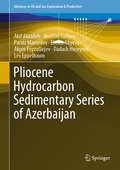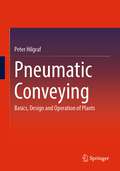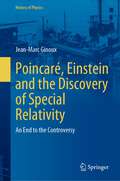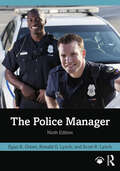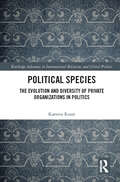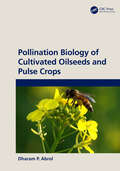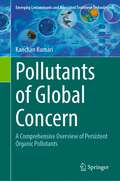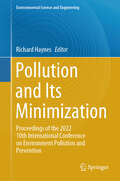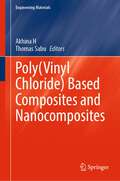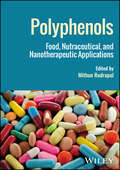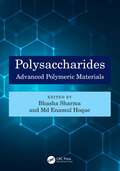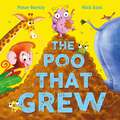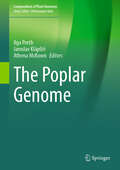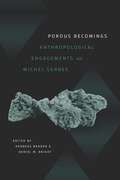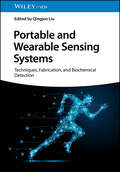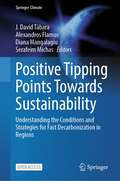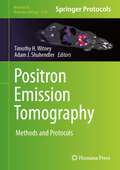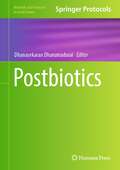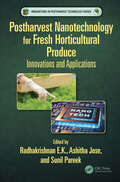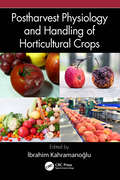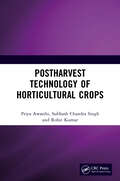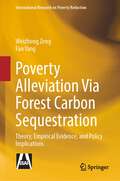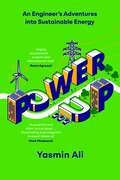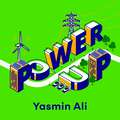- Table View
- List View
Pliocene Hydrocarbon Sedimentary Series of Azerbaijan (Advances in Oil and Gas Exploration & Production)
by Akif Alizadeh Ibrahim Guliyev Parviz Mamedov Elmira Aliyeva Akper Feyzullayev Dadash Huseynov Lev EppelbaumThis book demonstrates different stages of hydrocarbon deposit localization in a tectonically complex region—the South Caspian Mega-Basin (SCMB). Each of the stages: tectonics, sedimentation, lithology, structural analysis, and geophysical method application is described in detail and accompanied by numerous color (major) and black-white (minor) illustrations. The main benefit of this book is that the Azerbaijan hydrocarbon province has been investigated for more than 150 years, resulting in a very comprehensive archive of geological information. This book is intended not only for students of various degrees, but also for professional geologists studying principles of hydrocarbon accumulations under difficult geological environments.
Pneumatic Conveying: Basics, Design and Operation of Plants
by Peter HilgrafBulk materials are processed and refined in many industrial plants. They are transported back and forth between the various process steps. If bulk materials are dust-fine to coarse-grained, they can be transported pneumatically through pipelines with flowing gas - over distances of several metres to several kilometres.This book introduces the basics of pneumatic conveying, the construction of plants and their operation. The first three chapters deal with the physical properties of the bulk material and the conveying gas as well as their behaviour in gas-solid systems. The following chapter describes the application of these basics in pneumatic conveying: starting with different flow forms, via processes at the plug, up to pressure loss in pneumatic conveying lines. The following sections are devoted, among other things, to calculation approaches for the transfer of test models to large-scale systems, as well as to modern dense-phase conveying methods in which material to be conveyed moves at low speed in the form of threads, plugs or flowing. Separate chapters deal with the design of pneumatic conveying systems and various forms and causes of their wear.The book offers calculation examples for many topics and is state of the art. It is aimed at engineers, plant constructors and operators of product lines with pneumatic conveying. They benefit from the author's decades of experience in the development and design of plants with new conveying processes.
Poincaré, Einstein and the Discovery of Special Relativity: An End to the Controversy (History of Physics)
by Jean-Marc Ginoux1905 is probably the best-known year in physics, since it was the year of the discovery of the special theory of relativity. For decades, historiography has told us that Albert Einstein, then a patent examiner in Bern, succeeded in developing this theory on his own, overcoming all the difficulties that the greatest scientists of his time had not been able to solve. However, some have pointed out that, before Einstein’s first publication in this field, the French mathematician and physicist Henri Poincaré had obtained the same results, which he had published several months before Einstein. Yet today, this theory is known as Einstein’s special theory of relativity. Thus, considering the indisputable anteriority of Poincaré’s contributions, there is only one real question that needs to be answered:Why didn’t Poincaré claim the authorship of special theory of relativity?After recapping on the ideas and concepts of the special theory of relativity in a manner accessibleto non-specialists and recalling the historical context of the discovery of this theory, we will answer this question and thus put finally an end to this long-running controversy.
The Police Manager
by Egan K. Green Ronald G. Lynch Scott R. LynchThe Police Manager provides a roadmap for the challenges that police administrators face in their day-to-day duties, including considerations for dealing with subordinate officers and for interacting with the public. Covering a wide range of topics, from fiscal management to use-of-force policies, this text prepares readers for the tasks that police managers are confronted with. Readers benefit by gaining a thorough understanding of the complexities involved in an occupation that creates demands from the public, from public officials, and from other police officers. The book delivers information on these issues, with chapters dedicated to leadership styles and planning for leadership loss, as well civil liability considerations. New material in this edition covers specific challenges for small and underexamined police agencies such as university police departments. The Police Manager is an ideal textbook for college students hoping to work in police administration in the future, and is useful for current police managers who know that their jobs require a constant influx of ideas for overcoming new challenges.
Political Species: The Evolution and Diversity of Private Organizations in Politics (ISSN)
by Karsten RonitIn Political Species, Karsten Ronit expertly argues that evolutionary biology can provide important sources of inspiration for analyzing the proliferation of private actors/organizations in domestic and global politics. Focusing on the evolution of a diversity of such private actors/organizations in politics, Ronit emphasizes that individuals are affected by and contribute to societal, cultural, and political evolution through a range of formal organizations and that societies, cultures, and politics influence and build upon values and norms transmitted by individuals via these formal organizations. By being mindful of these contextual factors and keeping in mind the important research done in the micro- and macro-perspectives, we can gain a better understanding of the diversity of private actors/organizations and how they evolve and adapt. Evolutionary biology teaches us that over time, different varieties emerge, specialize, and adapt to the ever-changing conditions in complex environments before accumulating into new species. Much change characterizes these processes of political evolution because actors constantly emerge and add to the existing population of private actors that, in one way or another, are engaged in politics.
Pollination Biology of Cultivated Oil Seeds and Pulse Crops
by DP AbrolThe book provides in detail information on pollination biology of oilseed and pulse crops. The book presents information on improving productivity of oilseed crops and pulses through planned pollination and safety of pollinators from pesticides. Covering the latest information on various major world oil crops and pulses, this book brings the latest advances together in a single volume for researchers and advanced-level students. The book will enlighten the readers with the latest technological developments in pollination of oilseed crops and pulses and shall be useful to agricultural and applied scientists, extension workers, policy planners, and policymakers to improve rural economy and conservation of global biodiversity.Salient Features Covers the latest information on various aspects of pollination biology of oilseed and pulses crops and brings the latest advances together in a single volume for researchers and advanced level students. An excellent source of advanced study material for academics, researchers, and students and program planners Provides an excellent source of livelihood through enhanced productivity of oilseed and pulse crops. Aims to promote a large, diverse, sustainable, and dependable bee pollinator workforce that can meet the challenge for optimizing production of oil and pulse crops well into the twenty-first century. The pollination requirements of most of the pulse crops have been reported to benefit production of pulse crops both qualitatively and quantitatively. This book will be useful for pollination biologists; honeybee biologists; scientists working in agriculture, animal behaviour, conservation, biology, and ecology; entomologists; environmental biologists, etc.
Pollutants of Global Concern: A Comprehensive Overview of Persistent Organic Pollutants (Emerging Contaminants and Associated Treatment Technologies)
by Kanchan KumariThis book is a compilation of all the necessary attributes associated with the knowledge of Persistent Organic Pollutants (POPs) that have been meticulously identified and charted down by the Stockholm Convention. Essential details starting from technical characteristics of the POPs to their expanse of nationwide usage, their remedial procedures adopted in India in comparison to available international data, and their consequent effects on biota and future perspectives are summarized with precision. Additionally, in-house scientific works that have been performed on each chemical are presented. Moreover, a unique feature of this book is that each chapter is dedicated to focusing on a single POP so that all the aspects of its usage, effects and fate can be accurately laid out. The book aims to be a go-to guidebook for stakeholders and academicians dealing with these chemicals who wish to be more acquainted with the present scenario of POPs and their status.
Pollution and Its Minimization: Proceedings of the 2022 10th International Conference on Environment Pollution and Prevention (Environmental Science and Engineering)
by Richard HaynesThis book presents peer-reviewed papers of the 2022 10th International Conference on Environment Pollution and Prevention (ICEPP 2022), which was held in Sydney, Australia, during December 16–18, 2022. With the worldwide increase in industrialization and movement of people toward larger cities, there has been a progressive increase in environmental pollution. The issues surrounding air, water, soil, and land pollution are now considered of global concern. Minimization of pollution involves the repeated reuse of products, reduction in waste generation, and processing and recycling of resources into new products. Pollution prevention practices not only reduce waste, but also improve safety and decrease disposal costs. The book is useful for students, academics, entrepreneurs, and professionals who are working in the important field of environmental pollution and its prevention.
Poly (Engineering Materials)
by Akhina H Thomas SabuThis book covers Poly(vinyl chloride) Fundamentals, Fabrication and characterization of PVC based composites and nanocomposites specifically natural fibre reinforced PVC composites, carbonaceous filler reinforced PVC composites , metal oxide fled PVC composites and nanocomposites etc. This book also covers the conducting PVC composites and recent advances in nanocomposites based on PVC .The rheological, mechanical, barrier, thermal, dielectric behaviour of PVC composites and nanocomposites are discussed in details.
Polyphenols: Food, Nutraceutical, and Nanotherapeutic Applications
by Mithun RudrapalPolyphenols Understand polyphenols and their benefits with this comprehensive overview Polyphenols are a group of beneficial compounds—including phenolic acids, flavonoids, anthocyanins, and others—that can be found in a vast range of plants and plant-based foods. Their health benefits and the variety of their applications in functional foods, dietary supplements, and similar areas have made polyphenols a $1 billion market, a figure that is expected to more than double in the next decade. This has placed increased emphasis on areas of cutting-edge research such as the use of bio-based nanodelivery systems to improve the oral bioavailability of polyphenols. Polyphenols constitutes a comprehensive introduction to these compounds, their health benefits, and their potential nutraceutical applications. It incorporates both the biochemical fundamentals of polyphenols and their precise potential to prevent numerous common diseases. The result is an essential reference for a vital, growing area of research and industry. Polyphenols readers will also find: Detailed coverage of polyphenols’ occurrence, bioactivity, and technological applications In-depth discussion of nano-based delivery systems to increase polyphenols’ therapeutic efficacy and oral bioavailability and to reduce required dosages Guidance for developing treatments for cancers, cardiovascular diseases, inflammatory conditions, and more Polyphenols is ideal for food scientists and manufacturers, medicinal chemists, pharmaceutical scientists, and any biochemical or biomedical researcher or professional working with polyphenols or plant-based foods.
Polysaccharides: Advanced Polymeric Materials
by Bhasha SharmaPolysaccharides offer unique and valuable functional properties, persisting in technological importance and poised to grow more critical due to sustainability demands and emerging applications in medical and life sciences. This contributed work presents comprehensive information about carbohydrate polymers, providing readers with an enhanced appreciation of carbohydrate structure and function, a new enzyme library, and extraction strategies that will help to advance a number of exciting domains of research, including genomics, proteomics, chemical synthesis, materials science, and engineering. Key Features Details the source, production, structures, properties, and current and potential applications of polysaccharides. Discusses general strategies of isolation, separation, and characterization of polysaccharides. Describes botanical, algal, animal, and microbial sources of polysaccharides. Demonstrates the importance of carbohydrates in new lead generation. Highlights the range of possibilities for polysaccharides to make real-world impact. Bhasha Sharma, Assistant Professor, Department of Chemistry, Shivaji College, University of Delhi, India. Enamul Hoque, Professor, Department of Biomedical Engineering, Military Institute of Science and Technology (MIST), Dhaka, Bangladesh.
The Poo That Grew
by Peter BentlyThe animals were in a funk. The poop was EVERYWHERE. It stuck to paw and claw and trunk, To tail and horn and hair. Dung beetles love to chew on other animals' tasty poo. But when the monkeys make fun of them for having such a stinky lunch, the beetles decide to munch elsewhere. What the monkeys didn't realise is that without the beetles, there's no one to clean up their business. And so, the pile of poo grew and grew and GREW. In this hilarious picture book, Peter Bently imagines what might happen if dung beetles stopped doing their job and shows children that every creature is important to our environment, even those that are small and smelly.
The Poplar Genome (Compendium of Plant Genomes)
by Ilga Porth Jaroslav Klápště Athena McKownThis book is the first comprehensive compilation of research on state‐of‐the-art genomics on the most advanced model tree species including genome assemblies, insights into genomic structural features and methylation patterns, whole‐genome resources used for population genomics and adaptation to climate, enabled breeding vs. classical genetics and traditional breeding, comparative genomics, and elucidations on functional genomics. The latest developments in the genomics of wood formation are particularly highlighted. Altogether, the book contains over 300 pages in over 15 chapters authored by globally reputed experts in the relevant fields of this tree crop’s genomics research. This book is useful for students, teachers, and scientists in academia and governmental or private tree improvement agencies or companies interested in genetics, pathology, entomology, physiology, molecular genetics and breeding, in vitro culture and genetic engineering, land restoration, and agroforestry solutions.
Porous Becomings: Anthropological Engagements with Michel Serres
by Andreas Bandak and Daniel M. KnightOne of the foremost intellectuals of his generation, French philosopher of science Michel Serres (1930–2019) broke free from disciplinary dogmas. His reflections on science, culture, technology, art, and religion have proved foundational to scholars across the humanities. The contributors to Porous Becomings bring the inspirational and enigmatic world of Serres to the attention of anthropology. Through ethnographic encounters as diverse as angels and religious conversion in Ethiopia, the percolation of war in Bosnia, and incarcerated bodies crossing the Atlantic, the contributors showcase how Serres’s interrogation of the fundamentals of human existence opens new pathways for anthropological knowledge. Proposing the notion of "porosity" to characterize permeability across boundaries of time, space, literary genre, and academic discipline, they draw on Serres to map the constellations that connect humans, time, technology, and planet Earth. The volume concludes with a conversation between the editors and Vibrant Matter author Jane Bennett.Contributors. Andreas Bandak, Jane Bennett, Tom Boylston, Steven D. Brown, Matei Candea, Alberto Corsín Jiménez, David Henig, Michael Jackson, Daniel M. Knight, Celia Lowe, Morten Nielsen, Stavroula Pipyrou, Elizabeth Povinelli, Andrew Shryock, Arpad Szakolczai
Portable and Wearable Sensing Systems: Techniques, Fabrication, and Biochemical Detection
by Qingjun LiuPortable and Wearable Sensing Systems Discover the sensors of the future with this comprehensive guide Chemical sensors and biosensors have advanced enormously in recent decades, driven by growth in other technological areas and the refinement of manufacturing processes. Advances, especially, in wireless technology and flexible electronics have dramatically increased the practicality and availability of portable or wearable sensing systems. These have the potential to revolutionize disease diagnosis, food analysis, and environment monitoring at the point of care. Portable and Wearable Sensing Systems: Techniques, Fabrication, and Biochemical Detection introduces these groundbreaking technologies and the underlying principles which make them possible. Beginning with an overview of the foundational optics and electrochemistry which power these systems, the book surveys methods of fabrication, applications, and projected future developments. The result is a comprehensive introduction to an essential medical and biochemical technology. Portable and Wearable Sensing Systems readers will also find: Treatment of body fluid detection, exhaled breath sensing, ingestible devices, and moreDetailed discussion of sensing system types including scattering, colorimetric, and chemiluminescenceForward-looking attention to the latest advances in every chapter Portable and Wearable Sensing Systems is ideal for analytical chemists, materials scientists, bioengineers, biochemists, and anyone working with sensing technologies.
Positive Tipping Points Towards Sustainability: Understanding the Conditions and Strategies for Fast Decarbonization in Regions (Springer Climate)
by J. David Tàbara Alexandros Flamos Diana Mangalagiu Serafeim MichasThis open access book provides the first comprehensive review of the state of the art of social tipping points applied to energy systems from a social interdisciplinary perspective. It does so by presenting a novel theory of systemic and transformative change, linking it to empirical cases assisted with relevant assessment methodologies, including modeling. The authors unveil the narratives and visions, the transformative capacities as well as deliberate strategies and collective actions that at one point in time have been able - or were prevented - to tip a given social-ecological system towards low-carbon, sustainable trajectories in diverse high-intensive carbon regions around the world. This volume shows that self-reinforcing learning feedbacks connecting transformative solutions and strategies across scales and domains can be induced by targeted policy interventions both in local and regional contexts. It further indicates how changes in behavioral patterns, supported by good governance of disruptive technologies, carbon (dis)investment and finance processes as well as new forms of civic engagement, can create the necessary transformative enabling conditions for the emergence of positive tipping points towards low-carbon sustainable futures. The book is a must-read for students, researchers, and scholars, as well as policy-makers and practitioners interested in a better understanding of sustainability, climate, and energy issues and in assessing the potential impacts and effectiveness of strategic interventions aimed at accelerating just sustainable decarbonization processes.
Positron Emission Tomography: Methods and Protocols (Methods in Molecular Biology #2729)
by Timothy H. Witney Adam J. ShuhendlerThis detailed volume explores key concepts and experimental design related to Positron Emission Tomography (PET) imaging that have revolutionized our understanding of human biology. The first part focuses on recent advances in radiotracer probe development to enable the detection of materials, from large macromolecules to complicated drug-like structures. The next section describes how key physiological and pathophysiological processes can be interrogated and quantifiably measured with this imaging technique. Finally, chapters examine important technological developments in the field that are revolutionizing the way these innovative PET probes are utilized in the clinic. Written for the highly successful Methods in Molecular Biology series, chapters include introductions to their respective topics, lists of the necessary materials and reagents, step-by-step and readily reproducible laboratory protocols, as well as tips on troubleshooting and avoiding known pitfalls. Authoritative and practical, Positron Emission Tomography: Methods and Protocols serves as an ideal guide for researchers looking to use imaging to revolutionize the way we diagnose and treat disease.
Postbiotics (Methods and Protocols in Food Science)
by Dhanasekaran DharumaduraiThis volume details preparations, separations, identification, analysis of postbiotics types and mechanism, uses of postbiotics in health, pharma, aquacultures, and the food industry. Divided into five sections chapters provide methods on antimicrobials, antibiofilm, anti-inflammatory, antiallergies, antiobesity, meurotransmitter activity, dietary supplementation and Immunomodulatory activity of postbiotics, postbiotics as biopreservatives , and as well as food packing material. . Written in the format of the Methods and Protocols in Food Science series, chapters list necessary materials and methods for readily reproducible protocols. Authoritative and cutting-edge, Postbiotics aims to be a foundation for future studies and to be a source of inspiration for new investigations in the field.
Postharvest Nanotechnology for Fresh Horticultural Produce: Innovations and Applications (Innovations in Postharvest Technology Series)
by Radhakrishnan E. K. Ashitha Jose Sunil PareekFood scarcity and insecurity is an alarming issue throughout the world. Postharvest loss due to both mechanical damage and microbial spoilage significantly influences the shelf life and hence the availability of agricultural produce. Once initiated, the microbial spoilage can make bulk quantity of a given agricultural product unacceptable for human consumption, and several methods have already been used to try to manage this. Considering the limited success of the available methods, there is increasing interest in exploring nanotechnological methods. These methods are being considered for both the development of various platforms for antimicrobial/barrier packaging applications that minimize the contact of agricultural produce with the external environment, and also for design sensors to ensure food safety and quality. The impact of various nano-systems developed through material engineering on the shelf-life enhancement and storage of fresh horticultural produce will have revolutionary effects on post-harvest management in the coming years. Hence, Postharvest Nanotechnology for Fresh Horticultural Produce has been edited to advance understanding of material development, intelligent selection of nanomaterials to ensure the nontoxic nature, and future perspectives of nanotechnology on postharvest produce. This includes various types of nanoparticles exploited for the postharvest management, their mechanism of action, varied applications and material engineering, along with natural products including essential oils and plant bioactives, modelling of various tailor-made materials to meet the required properties of the packed food, advancements in the nanotechnological applications for the minimally processed food, and the toxicity concerns. Key Features: · Describes advances in nanotechnology for postharvest management · Includes extensive details on the applications of material engineering for post-harvest applications using nanotechnology and future aspects · Provides extensive data on the types of nanomaterials used and the fabrication methods employed for the design of tailor-made products for the post-harvest management This book reviews the current scientific advancements and future prospects of the nanotechnological interventions in meeting the quality and quantity standards of the horticultural produce and minimally processed food and will be a valuable reference for beginners, researchers, subject experts, and industrialists.
Postharvest Physiology and Handling of Horticultural Crops
by İbrahim KahramanoğluThe increase in global population compels growers to use excessive fertilizers to enhance agricultural production. Excessive fertilizer use may also negatively affect the nutritional quality and preservation of horticultural products, reducing the shelf life and overall quality of fruits and vegetables. Postharvest Physiology and Handling of Horticultural Crops contains fundamental information that helps readers understand postharvest physiology of fresh fruits and vegetables, and presents an in-depth analysis of the harmful impacts of agrochemicals. The book presents readers with eco-friendly, innovative techniques used to handle the fruits and vegetables during storage and through supply chains helping to better preserve them. Features · Describes available technologies to eliminate and minimize microbial infection for maintaining postharvest quality and safety of fresh produce. · Explores and discusses approaches, technologies, and management practices necessary to maintain products’ storage quality by ensuring food safety and nutrition retention. · Provides practical applications of latest developments in disinfection applications, smart packaging, nano-enabled applications, advances in fresh-cut products, light illumination and edible coatings. · Presents an in-depth discussion of the harmful impacts of agrochemicals and aims to introduce new, eco-friendly and innovative technologies to the readers. With chapters written by experts in the field of postharvest fruit and vegetable preservation, this book provides information on the use of biomaterials in food preservation and provides practical information for students, teachers, professors, scientists, farmers, food packers and sellers; as well as entrepreneurs engaged in the fresh food preservation industry.
Postharvest Technology of Horticultural Crops
by Priya Awasthi Subhash Chandra Singh Rohit KumarThis book is an informative introduction to the post-harvest technology of horticultural crops, and their conservation and management. The different post-harvest handling operations including storage aspects are also covered. Innovative processing technologies like high-pressure processing, irradiation, cold plasma technique and ohmic heating are also discussed in the book.
Poverty Alleviation Via Forest Carbon Sequestration: Theory, Empirical Evidence, and Policy Implications (International Research on Poverty Reduction)
by Weizhong Zeng Fan YangThis book focuses on two issues: the creation of benefits and opportunities for the poverty-stricken people and the trade-off between FCS and poverty alleviation. At the theoretical level, it explains the essential characteristics of PAFCS, analyses the impact mechanism of FCS projects in poverty alleviation, clarifies the stakeholders and their interests and demands, and delineates the dynamic mechanism of FCS projects and poverty alleviation. Based on this theoretical framework, the current situation and challenges for PAFCS in southwest China's ethnic areas are examined in depth. Project performance was quantitatively measured both for projects themselves and for community farmers. The research emphasises that FCS projects in poverty-stricken areas are not the same as PAFCS, highlights the combination of poverty alleviation theory and ecological compensation theory, and considers PAFCS as an intersection of poverty research and ecological compensation research. Additionally, theresearch suggested that FCS projects are not general poverty alleviation projects, highlights the need for full respect to be granted to the subjective will and value judgement of farmers, including poverty-stricken farmers, takes the lead in focusing on the win–win goal of combating climate change and reducing poverty, and makes a breakthrough in researching some key issues that need to be solved in the practice of PAFCS in the ethnic areas of Southwest China. This book is helpful for global scholars in the field of sustainable development, anti-poverty and forest carbon sequestration, government officials, and organisations in developing countries concerned with agricultural development, forestry economy, and sustainable development, as well as all the people around the world who want to find innovative solutions in the climate negotiations.
Power Up: An Engineer's Adventures into Sustainable Energy
by Yasmin Ali'A stimulating and affable overview of how major feats of engineering can help the world beat the climate crisis'NEW STATESMAN'A powerful and often lyrical book ... Fascinating and insightful in equal measure'MARK MIODOWNIK'Ali's enthusiasm for energy infrastructure electrifies this engaging tour of the people and structures that power our modern world'GAIA VINCE'Highly recommend ... a warm and educational read'ROMA AGRAWAL__________We rarely think about the energy systems that prop up our existence. With hot water, lighting and digital entertainment all available at the flick of a switch, it's easy to underestimate the vast global network that makes these things possible.Growing up in Iraq, Yasmin Ali regularly experienced power cuts - ironic for a country rich in oil and sunshine. Now as an engineer working in energy, Yasmin has a deep appreciation for what these resources mean for our lives. In Power Up she takes us on a journey across the globe to reveal the bigger picture, from solar farms shimmering in the desert to power stations hidden deep in the mountains. We discover where we get energy from, how it is moved and used around the world - and why we need to understand the whole system if we want to transition towards a clean, green future.Power Up is a definitive picture of the intricate world that humanity has built, and a rallying cry to face the challenges of climate change using the power at our fingertips.
Power Up: An Engineer's Adventures into Sustainable Energy
by Yasmin Ali'A stimulating and affable overview of how major feats of engineering can help the world beat the climate crisis'NEW STATESMAN'A powerful and often lyrical book ... Fascinating and insightful in equal measure'MARK MIODOWNIK'Ali's enthusiasm for energy infrastructure electrifies this engaging tour of the people and structures that power our modern world'GAIA VINCE'Highly recommend ... a warm and educational read'ROMA AGRAWAL__________We rarely think about the energy systems that prop up our existence. With hot water, lighting and digital entertainment all available at the flick of a switch, it's easy to underestimate the vast global network that makes these things possible.Growing up in Iraq, Yasmin Ali regularly experienced power cuts - ironic for a country rich in oil and sunshine. Now as an engineer working in energy, Yasmin has a deep appreciation for what these resources mean for our lives. In Power Up she takes us on a journey across the globe to reveal the bigger picture, from solar farms shimmering in the desert to power stations hidden deep in the mountains. We discover where we get energy from, how it is moved and used around the world - and why we need to understand the whole system if we want to transition towards a clean, green future.Power Up is a definitive picture of the intricate world that humanity has built, and a rallying cry to face the challenges of climate change using the power at our fingertips.
Power Up: An Engineer's Adventures into Sustainable Energy
by Yasmin Ali'A stimulating and affable overview of how major feats of engineering can help the world beat the climate crisis'NEW STATESMAN'A powerful and often lyrical book ... Fascinating and insightful in equal measure'MARK MIODOWNIK'Ali's enthusiasm for energy infrastructure electrifies this engaging tour of the people and structures that power our modern world'GAIA VINCE'Highly recommend ... a warm and educational read'ROMA AGRAWAL__________We rarely think about the energy systems that prop up our existence. With hot water, lighting and digital entertainment all available at the flick of a switch, it's easy to underestimate the vast global network that makes these things possible.Growing up in Iraq, Yasmin Ali regularly experienced power cuts - ironic for a country rich in oil and sunshine. Now as an engineer working in energy, Yasmin has a deep appreciation for what these resources mean for our lives. In Power Up she takes us on a journey across the globe to reveal the bigger picture, from solar farms shimmering in the desert to power stations hidden deep in the mountains. We discover where we get energy from, how it is moved and used around the world - and why we need to understand the whole system if we want to transition towards a clean, green future.Power Up is a definitive picture of the intricate world that humanity has built, and a rallying cry to face the challenges of climate change using the power at our fingertips.
